Index to Flowers in the Order Cucurbitales
Family: Cucurbitaceae
Acanthosicyos naudinianus Gemsbok Cucumber, Wild Watermelon https://africawild-forum.com/viewtopic.p ... 40#p170630
Citrullus lanatus Tsamma Melon, Wild Watermelon https://africawild-forum.com/viewtopic.p ... 11#p170704
Cucumis africanus Wild Cucumber, Wild Gherkin https://africawild-forum.com/viewtopic.p ... 11#p170705
Cucumis anguria Gherkin Cucumber https://africawild-forum.com/viewtopic.p ... 11#p170706
Cucumis metuliferus African Horned Cucumber, Jelly Melon, Kiwano https://africawild-forum.com/viewtopic.p ... 11#p170707
Cucumis Zeyheri South African Spiny Cucumber, Wild Cucumber https://africawild-forum.com/viewtopic.p ... 11#p170708
Lagenaria sphaerica Wild Melon, Wild Calabash https://africawild-forum.com/viewtopic.p ... 11#p170709
Momordica balsamina Balsam Apple https://africawild-forum.com/viewtopic.p ... 36#p327036
Africa Wild Flower Book - Order Cucurbitales
Moderator: Klipspringer
- nan
- Posts: 26476
- Joined: Thu May 31, 2012 9:41 pm
- Country: Switzerland
- Location: Central Europe
- Contact:
Re: Africa Wild Flower Book - Order Cucurbitales
Gemsbok Cucumber, Wild Watermelon Acanthosicyos naudinianus (Gemsbokkomkommer)
Order: Cucurbitales. Family: Cucurbitaceae
 © nan
© nan
Kgalagadi Transfrontier Park
Description
The Gemsbok Cucumber is a herbaceous perennial plant with annual creeping vines from an underground tuberous rootstock, with a disproportionately large fleshy root that penetrates a meter or more into the sand. The 15 centimetre thick root will grow to one meter in length, the vines reach for up to six meters. Tendrils modified into weak spines. Leaves usually deeply pamately 5-lobed, with lanceolate lobes which are more or less irregularly lobed or toothed again, cordate at the base, softly to roughly hairy on both surfaces, particularly on the veins. Flowers solitary, axillary, sexes on different plants, yellow to white. Fruit is oval-shaped, ellipsoid to almost round, 6-12 cm long, blue-green, turning pale yellow when ripe, covered in bristle-tipped spines.
Distribution
Botswana, Namibia, Mozambique, Zambia, Zimbabwe, South Africa (Provincial distribution: Free State, Gauteng, KwaZulu-Natal, Limpopo, Northern Cape, North West).
Habitat
On sandy soils in dry woodland and grassland.
Despite its bitterness, is it much favoured by Gemsbok and Mole-Rat and its also eaten by Jackal and Honey Badger. Squirrel, Porcupine, Crickets and an array of other rodens and insects use the water that gathers in the old shells after rains.
(Official information guide of Kgalagadi Transfrontier Park)
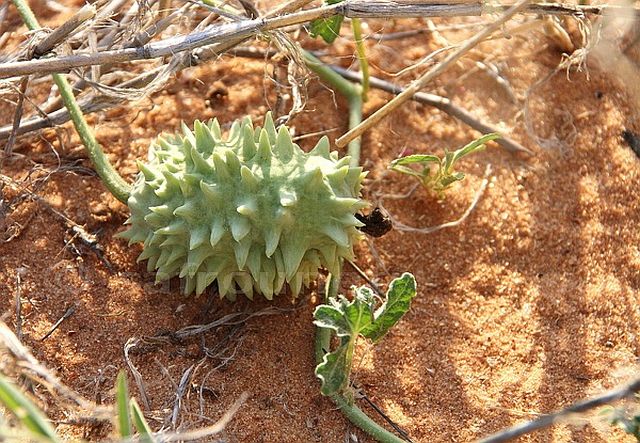 © nan
© nan
Kgalagadi Transfrontier Park
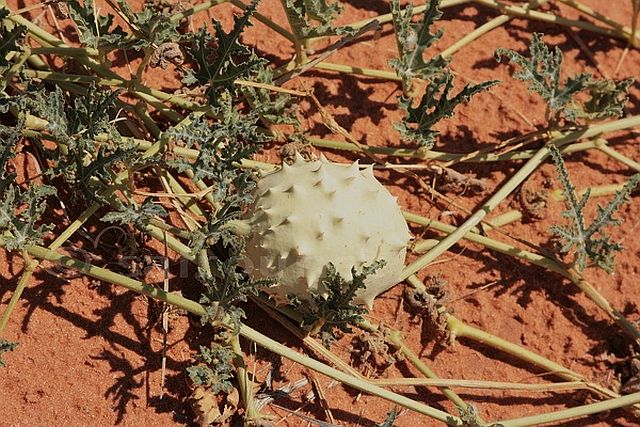 © nan
© nan
Kgalagadi Transfrontier Park
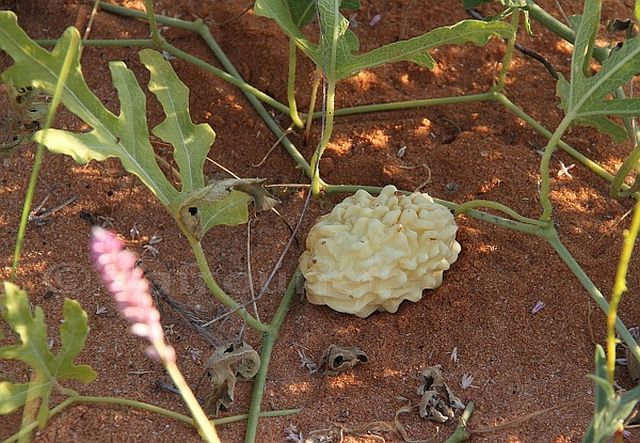 © nan
© nan
Kgalagadi Transfrontier Park
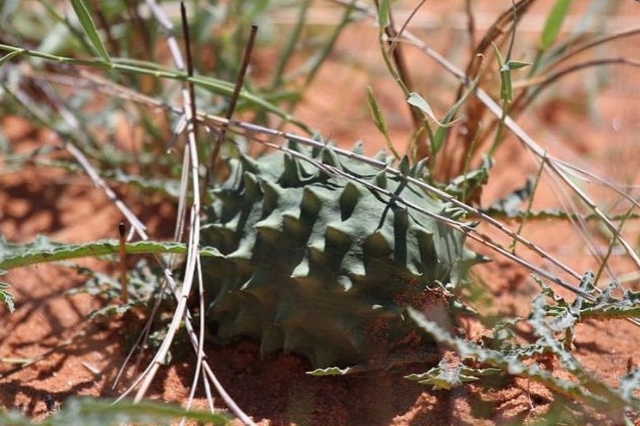 © Sharifa
© Sharifa
Gharagab area, Kgalagadi Transfrontier Park
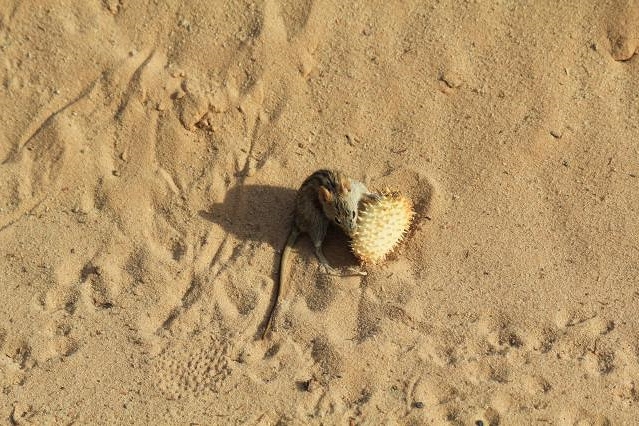 © General Gump
© General Gump
Kgalagadi Transfrontier Park
Order: Cucurbitales. Family: Cucurbitaceae
 © nan
© nanKgalagadi Transfrontier Park
Description
The Gemsbok Cucumber is a herbaceous perennial plant with annual creeping vines from an underground tuberous rootstock, with a disproportionately large fleshy root that penetrates a meter or more into the sand. The 15 centimetre thick root will grow to one meter in length, the vines reach for up to six meters. Tendrils modified into weak spines. Leaves usually deeply pamately 5-lobed, with lanceolate lobes which are more or less irregularly lobed or toothed again, cordate at the base, softly to roughly hairy on both surfaces, particularly on the veins. Flowers solitary, axillary, sexes on different plants, yellow to white. Fruit is oval-shaped, ellipsoid to almost round, 6-12 cm long, blue-green, turning pale yellow when ripe, covered in bristle-tipped spines.
Distribution
Botswana, Namibia, Mozambique, Zambia, Zimbabwe, South Africa (Provincial distribution: Free State, Gauteng, KwaZulu-Natal, Limpopo, Northern Cape, North West).
Habitat
On sandy soils in dry woodland and grassland.
Despite its bitterness, is it much favoured by Gemsbok and Mole-Rat and its also eaten by Jackal and Honey Badger. Squirrel, Porcupine, Crickets and an array of other rodens and insects use the water that gathers in the old shells after rains.
(Official information guide of Kgalagadi Transfrontier Park)
 © nan
© nanKgalagadi Transfrontier Park
 © nan
© nanKgalagadi Transfrontier Park
 © nan
© nanKgalagadi Transfrontier Park
 © Sharifa
© SharifaGharagab area, Kgalagadi Transfrontier Park
 © General Gump
© General GumpKgalagadi Transfrontier Park
Kgalagadi lover… for ever
https://safrounet.piwigo.com/
https://safrounet.piwigo.com/
Re: Africa Wild Flower Book - Order Cucurbitales
Tsamma Melon, Wild Watermelon Citrullus lanatus
Order: Cucurbitales. Family: Cucurbitaceae


Kgalagadi Transfrontier Park
Description
A prostrate or climbing annual with several herbaceous, rather firm and stout stems up to 3 m long; the young parts are densely woolly with yellowish to brownish hairs while the older parts become hairless. The leaves are herbaceous but rigid, becoming rough on both sides; 60–200 mm long and 40–150 mm broad, ± ovate in outline, sometimes unlobed and ± entire, but usually deeply 3-lobed with the segments again lobed or doubly lobed; the central lobe is much the largest. The leaf stalks are somewhat hairy and up to 150 mm long. The tendrils are rather robust and usually divided in the upper part.
Male and female flowers occur on the same plant (monoecious) with the flower stalk up to 40 mm long and hairy. The receptacle is up to 4 mm long, broadly campanulate and hairy, the lobes are ± as long as the tube. The corolla is usually ± green or green-veined outside and white to pale or bright yellow inside and up to 30 mm in diameter.
The fruit in the wild form is subglobose, indehiscent and up to 200 mm in diameter; the fruit stalk is up to 50 mm long. The fruits in the cultivated forms are globose to ellipsoid or oblong and up to 600 mm long and 300 mm in diameter. The rind in the ripe fruit is hairless and smooth, hard but not woody. In the wild forms the rind is pale or grey-green, usually mottled with irregular longitudinal bands of dark green or grey-green. In cultivated forms the rind is often concolorous yellowish to pale or dark green, or mottled with darker green, or marbled with a darker shade. The flesh is firm and rather hard, white, green-white or yellowish. The seeds are numerous, ± ovate in outline, sometimes bordered; in wild forms they are usually black or dark brown; in cultivated forms they are also white or mottled, mostly 6–12 mm long.
Distribution
Not endemic to South Africa. Native to the Kalahari sand region, including Botswana, Zambia, Western Zimbabwe and Soth Africa (Provincial distribution: Eastern Cape, Free State, Gauteng, KwaZulu-Natal, Limpopo, Mpumalanga, Northern Cape, North West).
Habitat
Wild plants occur in Kalaharisand areas in grassland and scrubland, often along watercourses.
Links: PlantZAfrica
Order: Cucurbitales. Family: Cucurbitaceae


Kgalagadi Transfrontier Park
Description
A prostrate or climbing annual with several herbaceous, rather firm and stout stems up to 3 m long; the young parts are densely woolly with yellowish to brownish hairs while the older parts become hairless. The leaves are herbaceous but rigid, becoming rough on both sides; 60–200 mm long and 40–150 mm broad, ± ovate in outline, sometimes unlobed and ± entire, but usually deeply 3-lobed with the segments again lobed or doubly lobed; the central lobe is much the largest. The leaf stalks are somewhat hairy and up to 150 mm long. The tendrils are rather robust and usually divided in the upper part.
Male and female flowers occur on the same plant (monoecious) with the flower stalk up to 40 mm long and hairy. The receptacle is up to 4 mm long, broadly campanulate and hairy, the lobes are ± as long as the tube. The corolla is usually ± green or green-veined outside and white to pale or bright yellow inside and up to 30 mm in diameter.
The fruit in the wild form is subglobose, indehiscent and up to 200 mm in diameter; the fruit stalk is up to 50 mm long. The fruits in the cultivated forms are globose to ellipsoid or oblong and up to 600 mm long and 300 mm in diameter. The rind in the ripe fruit is hairless and smooth, hard but not woody. In the wild forms the rind is pale or grey-green, usually mottled with irregular longitudinal bands of dark green or grey-green. In cultivated forms the rind is often concolorous yellowish to pale or dark green, or mottled with darker green, or marbled with a darker shade. The flesh is firm and rather hard, white, green-white or yellowish. The seeds are numerous, ± ovate in outline, sometimes bordered; in wild forms they are usually black or dark brown; in cultivated forms they are also white or mottled, mostly 6–12 mm long.
Distribution
Not endemic to South Africa. Native to the Kalahari sand region, including Botswana, Zambia, Western Zimbabwe and Soth Africa (Provincial distribution: Eastern Cape, Free State, Gauteng, KwaZulu-Natal, Limpopo, Mpumalanga, Northern Cape, North West).
Habitat
Wild plants occur in Kalaharisand areas in grassland and scrubland, often along watercourses.
Links: PlantZAfrica
Re: Africa Wild Flower Book - Order Cucurbitales
Wild Cucumber, Springbok Cucumber, Wild Gherkin Cucumis africanus (Wilde Agurkie, Doringkomkommertjie)
Order: Cucurbitales. Family: Cucurbitaceae
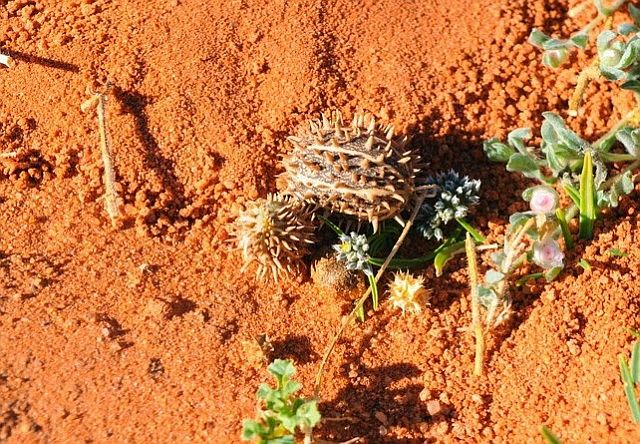 © AstroMatt
© AstroMatt
!Ae!Hai Kalahari Heritage Park
Description
Perennial herb. Rootstock thick and woody. Stems annual, up to more than 2 m long, finely ridged, roughly whitish hairy, usually prostrate, but will climb on bushes and other support; cut twigs exude clear sap. Leaves broadly ovate, deeply 5-palmately lobed, 15-115 mm long, dull green, roughly hairy on both sides with bulbous-based hairs; crushed leaves non-aromatic. Leaf stalks finely ridged and roughly hairy, up to 80 mm long. Tendrils simple. Flowers pale to dark yellow with green veins, either male or female, both appearing on the same plant. Male flowers in groups of 5-10, petals up to 9 mm long. Female flowers solitary, petals up to ± 11 mm long. Ripe fruit 30-80 x up to 3o mm, prickly, prickles up to 10 mm long, fleshy to hard, base flat; unripe fruit longitudinally striped dark and light green, maturing to greenish yellow or white, striped purplish brown or yellow, prickles mainly on dark bands; occurring in two distinct forms, either small, ellipsoidal, bitter and poisonous when ripe, or large, cylindrical, non-bitter and edible when ripe; flesh green and translucent, many-seeded. Seeds elliptic, about 4.5 x 2.5 mm, and 1 mm thick, cream-coloured.
Distribution
Cucumis africanus is indigenous to Africa and occurs from the woodlands of Angola and Zimbabwe to Namibia, Botswana and South Africa. In South Africa it is found in Limpopo, North-West, Gauteng, Mpumalanga, KwaZulu-Natal, Northern, Western and Eastern Cape. It is rare in Mpumalanga, KwaZulu-Natal and the Eastern Cape.
Habitat
The plant is widely distributed in arid areas and savannas. Woodland and wooded grassland, often on Kalahari sand, and on abandoned cultivated land 200–1500 m.
Order: Cucurbitales. Family: Cucurbitaceae
 © AstroMatt
© AstroMatt!Ae!Hai Kalahari Heritage Park
Description
Perennial herb. Rootstock thick and woody. Stems annual, up to more than 2 m long, finely ridged, roughly whitish hairy, usually prostrate, but will climb on bushes and other support; cut twigs exude clear sap. Leaves broadly ovate, deeply 5-palmately lobed, 15-115 mm long, dull green, roughly hairy on both sides with bulbous-based hairs; crushed leaves non-aromatic. Leaf stalks finely ridged and roughly hairy, up to 80 mm long. Tendrils simple. Flowers pale to dark yellow with green veins, either male or female, both appearing on the same plant. Male flowers in groups of 5-10, petals up to 9 mm long. Female flowers solitary, petals up to ± 11 mm long. Ripe fruit 30-80 x up to 3o mm, prickly, prickles up to 10 mm long, fleshy to hard, base flat; unripe fruit longitudinally striped dark and light green, maturing to greenish yellow or white, striped purplish brown or yellow, prickles mainly on dark bands; occurring in two distinct forms, either small, ellipsoidal, bitter and poisonous when ripe, or large, cylindrical, non-bitter and edible when ripe; flesh green and translucent, many-seeded. Seeds elliptic, about 4.5 x 2.5 mm, and 1 mm thick, cream-coloured.
Distribution
Cucumis africanus is indigenous to Africa and occurs from the woodlands of Angola and Zimbabwe to Namibia, Botswana and South Africa. In South Africa it is found in Limpopo, North-West, Gauteng, Mpumalanga, KwaZulu-Natal, Northern, Western and Eastern Cape. It is rare in Mpumalanga, KwaZulu-Natal and the Eastern Cape.
Habitat
The plant is widely distributed in arid areas and savannas. Woodland and wooded grassland, often on Kalahari sand, and on abandoned cultivated land 200–1500 m.
- nan
- Posts: 26476
- Joined: Thu May 31, 2012 9:41 pm
- Country: Switzerland
- Location: Central Europe
- Contact:
Re: Africa Wild Flower Book - Order Cucurbitales
Gherkin Cucumber Cucumis anguria
Order: Cucurbitales. Family: Cucurbitaceae
 © nan
© nan
Kruger National Park, Shireni
Description
Annual herb with prostrate or climbing stems up to 3 m long, with spreading bristly hairs. Leaves broadly ovate in outline, up to 10 × 12.5 cm, usually deeply 3-7 lobed, with bristly hairs on both surfaces, becoming roughly puntate; margin finely sinuate-denticulate; petiole 2-12 cm long, with long spreading bristly hairs. Flowers unisexual on the same plant, yellow. Male flowers in 2-10-flowered axillary clusters, c. 1.4 cm in diameter; female flowers solitary, c. 2 cm in diameter, sometimes in the same cluster as male flowers. Fruits subglobose or ellipsoid, up to 4.5 × 3.5 cm covered in soft spines, green, sometimes with pales stripes, turning pale yellow when ripe; fruit stalk 5-21 cm long, somewhat expanded upwards.
The fruits of this species are edible and the taste is similar to that of the commercial cucumber.
It is the only wild Cucumis species with prickly stems and leaf stalks.
Similar species: This species is generally similar to Cucumis zeyheri but that species, apart from being a perennial with very bitter, inedible fruit, has shorter, backwardly pointed bristly hairs on stems and petioles; has generally smaller, more globose fruits and much longer fruit stalks that are expanded towards the fruit.
Distribution
Widespread in tropical Africa, Australia and America but probably only native to Southern Africa. Provincial distribution is South Africa: KwaZulu-Natal, Limpopo, Mpumalanga. The Gherkin originates from southwestern Africa. Domestication of this species included selecting for sweeter fruits with shorter spines. The wild form is known as Cucumis anguria var. longaculeatus and in southern Africa occurs in Namibia, Botswana, Swaziland and South Africa.
Habitat
In open woodland and wooded grassland or in abandoned cultivation, often on kalahari sand.
 © Sprocky
© Sprocky
Tree squirrel eating the seeds, Grietjie Private Reserve
Links: Biodiversity Explorer; G. J. H. Grubben: Vegetables
Order: Cucurbitales. Family: Cucurbitaceae
 © nan
© nanKruger National Park, Shireni
Description
Annual herb with prostrate or climbing stems up to 3 m long, with spreading bristly hairs. Leaves broadly ovate in outline, up to 10 × 12.5 cm, usually deeply 3-7 lobed, with bristly hairs on both surfaces, becoming roughly puntate; margin finely sinuate-denticulate; petiole 2-12 cm long, with long spreading bristly hairs. Flowers unisexual on the same plant, yellow. Male flowers in 2-10-flowered axillary clusters, c. 1.4 cm in diameter; female flowers solitary, c. 2 cm in diameter, sometimes in the same cluster as male flowers. Fruits subglobose or ellipsoid, up to 4.5 × 3.5 cm covered in soft spines, green, sometimes with pales stripes, turning pale yellow when ripe; fruit stalk 5-21 cm long, somewhat expanded upwards.
The fruits of this species are edible and the taste is similar to that of the commercial cucumber.
It is the only wild Cucumis species with prickly stems and leaf stalks.
Similar species: This species is generally similar to Cucumis zeyheri but that species, apart from being a perennial with very bitter, inedible fruit, has shorter, backwardly pointed bristly hairs on stems and petioles; has generally smaller, more globose fruits and much longer fruit stalks that are expanded towards the fruit.
Distribution
Widespread in tropical Africa, Australia and America but probably only native to Southern Africa. Provincial distribution is South Africa: KwaZulu-Natal, Limpopo, Mpumalanga. The Gherkin originates from southwestern Africa. Domestication of this species included selecting for sweeter fruits with shorter spines. The wild form is known as Cucumis anguria var. longaculeatus and in southern Africa occurs in Namibia, Botswana, Swaziland and South Africa.
Habitat
In open woodland and wooded grassland or in abandoned cultivation, often on kalahari sand.
Tree squirrel eating the seeds, Grietjie Private Reserve
Links: Biodiversity Explorer; G. J. H. Grubben: Vegetables
Kgalagadi lover… for ever
https://safrounet.piwigo.com/
https://safrounet.piwigo.com/
Re: Africa Wild Flower Book - Order Cucurbitales
African Horned Cucumber, Jelly Melon, Kiwano Cucumis metuliferus (Rooi-agurkie, Rooikomkommer)
Order: Cucurbitales. Family: Cucurbitaceae

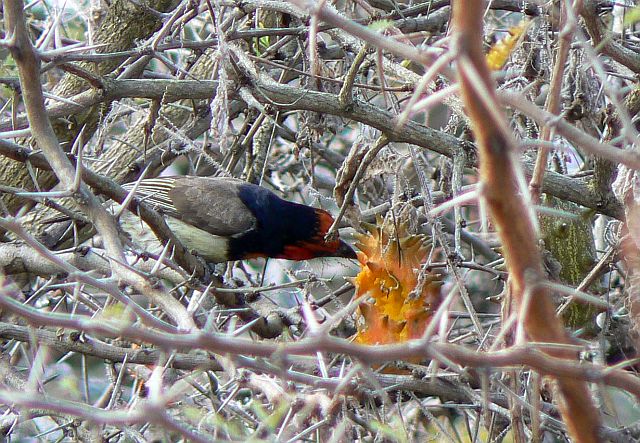
iMfolozi GR, Mpila, KwaZulu-Natal
Description
An annual climbing or rarely trailing herb; vegetative parts rough with spreading hairs. Stems are up to 3 m long, radiating from a woody rootstock. The leaves are broadly ovate-cordate in outline, up to 90 x 100 mm, unlobed or usually palmately 3–5-lobed, veins below very roughly hairy, margins minutely toothed; leaf stalks (petioles) up to 100 mm long. Both male and female flowers appear on the same plant (monoecious). Male flowers are solitary or up to 4 in sessile or short-stalked groups, greenish to light yellow, the corolla is 5–10 mm long. Female flowers are solitary on 20–60 mm long stalks; the ovary is up to 20 mm long, pale green with numerous minute, dark green fleshy spines, the corolla is yellow, 8–15 mm long. The fruit is ellipsoid-cylindrical, obscurely trigonous (triangular in shape), 60–150 mm long, 30–60 mm across when ripe, the scattered spines are rather stout, fleshy, ± 10 x 2–5 mm, broad-based, deep green-grey, ripening yellow to orange-red with obscure longitudinal stripes of small pale markings and rather softly fleshy. Seeds are ellipsoid, flattened, 6–9 mm long, numerous, embedded in a light green or emerald-green, jelly-like flesh.
Distribution
Tropical Africa south of the Sahara down to Namibia, Botswana, South Africa and Swaziland. In South Africa it is found in Limpopo, Mpumalanga and KwaZulu-Natal.
Habitat:
This species usually grows in shallow or deep, well-drained sand, mostly in alluvial soil on river banks, in river beds or flood plains; it is also recorded from clay or loam soil and rocky slopes. It climbs on trees, shrubs or grass in various vegetation types such as forest edges (often riverine), semi-evergreen forest, deciduous woodland (often with Acacia), savanna or grassland. The jelly melon also grows in disturbed areas and abandoned land.
Links: PlantZAfrica; G. J. H. Grubben: Vegetables
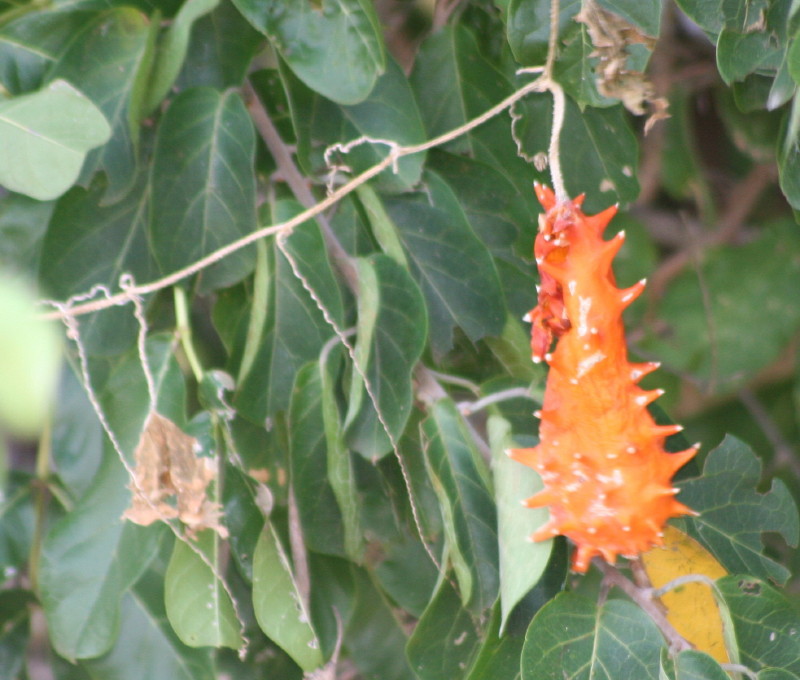 © okie
© okie
Kruger National Park, H1-3
Order: Cucurbitales. Family: Cucurbitaceae


iMfolozi GR, Mpila, KwaZulu-Natal
Description
An annual climbing or rarely trailing herb; vegetative parts rough with spreading hairs. Stems are up to 3 m long, radiating from a woody rootstock. The leaves are broadly ovate-cordate in outline, up to 90 x 100 mm, unlobed or usually palmately 3–5-lobed, veins below very roughly hairy, margins minutely toothed; leaf stalks (petioles) up to 100 mm long. Both male and female flowers appear on the same plant (monoecious). Male flowers are solitary or up to 4 in sessile or short-stalked groups, greenish to light yellow, the corolla is 5–10 mm long. Female flowers are solitary on 20–60 mm long stalks; the ovary is up to 20 mm long, pale green with numerous minute, dark green fleshy spines, the corolla is yellow, 8–15 mm long. The fruit is ellipsoid-cylindrical, obscurely trigonous (triangular in shape), 60–150 mm long, 30–60 mm across when ripe, the scattered spines are rather stout, fleshy, ± 10 x 2–5 mm, broad-based, deep green-grey, ripening yellow to orange-red with obscure longitudinal stripes of small pale markings and rather softly fleshy. Seeds are ellipsoid, flattened, 6–9 mm long, numerous, embedded in a light green or emerald-green, jelly-like flesh.
Distribution
Tropical Africa south of the Sahara down to Namibia, Botswana, South Africa and Swaziland. In South Africa it is found in Limpopo, Mpumalanga and KwaZulu-Natal.
Habitat:
This species usually grows in shallow or deep, well-drained sand, mostly in alluvial soil on river banks, in river beds or flood plains; it is also recorded from clay or loam soil and rocky slopes. It climbs on trees, shrubs or grass in various vegetation types such as forest edges (often riverine), semi-evergreen forest, deciduous woodland (often with Acacia), savanna or grassland. The jelly melon also grows in disturbed areas and abandoned land.
Links: PlantZAfrica; G. J. H. Grubben: Vegetables
 © okie
© okieKruger National Park, H1-3
- Flutterby
- Posts: 44029
- Joined: Sat May 19, 2012 12:28 pm
- Country: South Africa
- Location: Gauteng, South Africa
- Contact:
Re: Africa Wild Flower Book - Order Cucurbitales
South African Spiny Cucumber, Wild Cucumber Cucumis zeyheri (Bitterappel, Wilde-Agurkie or Wildekomkommer)
Order: Cucurbitales. Family: Cucurbitaceae

Description
Fairly fast growing vine to several feet in all directions. It is a perennial, but shoots die back out of season and grow from the woody base the following year. Like common cucumbers, this species has unisex flowers, but both male and female flowers are produced on the same plant. The fruits grow to a couple of inches and are colored green, often with off color spots. Fruits are covered in spines and ripen to a pale yellow. The species is very bitter in taste and inedible.
Distribution
Native from Zambia and Zimbabwe, south to South Africa (Provincial distribution: Eastern Cape, Free State, Gauteng, KwaZulu-Natal, Limpopo, Mpumalanga, Northern Cape, North West). The species is relatively common in its native range.
Habitat
In open woodland and grassland or as a weed of cultivation.
Order: Cucurbitales. Family: Cucurbitaceae

Description
Fairly fast growing vine to several feet in all directions. It is a perennial, but shoots die back out of season and grow from the woody base the following year. Like common cucumbers, this species has unisex flowers, but both male and female flowers are produced on the same plant. The fruits grow to a couple of inches and are colored green, often with off color spots. Fruits are covered in spines and ripen to a pale yellow. The species is very bitter in taste and inedible.
Distribution
Native from Zambia and Zimbabwe, south to South Africa (Provincial distribution: Eastern Cape, Free State, Gauteng, KwaZulu-Natal, Limpopo, Mpumalanga, Northern Cape, North West). The species is relatively common in its native range.
Habitat
In open woodland and grassland or as a weed of cultivation.
Re: Africa Wild Flower Book - Order Cucurbitales
Wild Melon, Wild Calabash Lagenaria sphaerica (Wildekalbas)
Order: Cucurbitales. Family: Cucurbitaceae

Kruger National Park
Description
Perennial with a woody rootstock. Stems annual, herbaceous, robust, climbing or trailing, angular, hairless, up to 10 m long or longer, often completely leafless when fruiting. Leaves rather rigid, shaped like a hand, deeply 5-lobed, margins toothed, 50-180 mm long, both surfaces roughly and shortly hairy, upper surface dark green, lower surface paler; foetid when crushed. Leaf stalks 20-80 mm long, with two lateral apical yellow-green glands. Tendrils split in two. Flowers fragrant, opening in the evenings, corollas saucer-shaped, velvety white or cream-coloured with green veins, petals rounded, 22-60 mm long; male and female flowers on separate plants (dioecious). Male flowers 2-10 in racemes, anthers prominent, yellow, greatly contorted. Female flowers solitary, stalked. Fruit hanging from a stout 30-100 mm long stalk, subspherical, 60-100 mm across, deep green with pale green or yellowish transverse, slightly raised patches, with a hard shell and whitish flesh, foul smelling when ripe. Seeds whitish to yellowish, oblong-triangular in outline, flattened, 10-15 mm long.
Distribution
These plants are found in low lying areas from the Eastern Cape of South Africa to east Africa. Provincial distribution: Eastern Cape, KwaZulu-Natal, Limpopo, Western Cape.
Habitat
The may grow along river floodplains or up into the canopy of riparian forests. They may also be found in coastal dune vegetation.
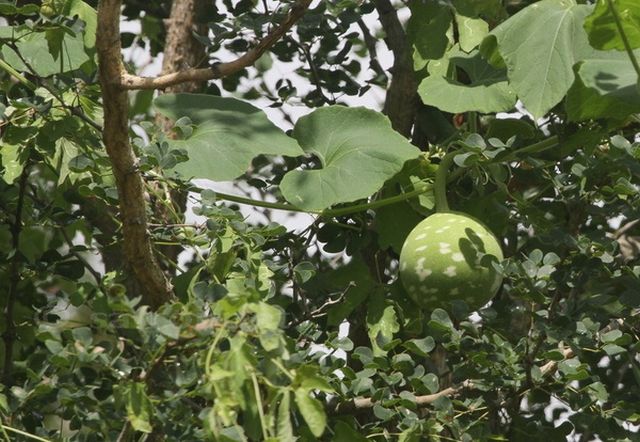 © nan
© nan
Kruger National Park, H1-3
 © Kesheshe
© Kesheshe
Kruger National Park
Order: Cucurbitales. Family: Cucurbitaceae

Kruger National Park
Description
Perennial with a woody rootstock. Stems annual, herbaceous, robust, climbing or trailing, angular, hairless, up to 10 m long or longer, often completely leafless when fruiting. Leaves rather rigid, shaped like a hand, deeply 5-lobed, margins toothed, 50-180 mm long, both surfaces roughly and shortly hairy, upper surface dark green, lower surface paler; foetid when crushed. Leaf stalks 20-80 mm long, with two lateral apical yellow-green glands. Tendrils split in two. Flowers fragrant, opening in the evenings, corollas saucer-shaped, velvety white or cream-coloured with green veins, petals rounded, 22-60 mm long; male and female flowers on separate plants (dioecious). Male flowers 2-10 in racemes, anthers prominent, yellow, greatly contorted. Female flowers solitary, stalked. Fruit hanging from a stout 30-100 mm long stalk, subspherical, 60-100 mm across, deep green with pale green or yellowish transverse, slightly raised patches, with a hard shell and whitish flesh, foul smelling when ripe. Seeds whitish to yellowish, oblong-triangular in outline, flattened, 10-15 mm long.
Distribution
These plants are found in low lying areas from the Eastern Cape of South Africa to east Africa. Provincial distribution: Eastern Cape, KwaZulu-Natal, Limpopo, Western Cape.
Habitat
The may grow along river floodplains or up into the canopy of riparian forests. They may also be found in coastal dune vegetation.
 © nan
© nanKruger National Park, H1-3
 © Kesheshe
© KeshesheKruger National Park
Re: Africa Wild Flower Book - Order Cucurbitales
Balsam Apple, African Cucumber Mormodica balsamina (Laloentjie)
Order: Cucurbitales. Family: Cucurbitaceae
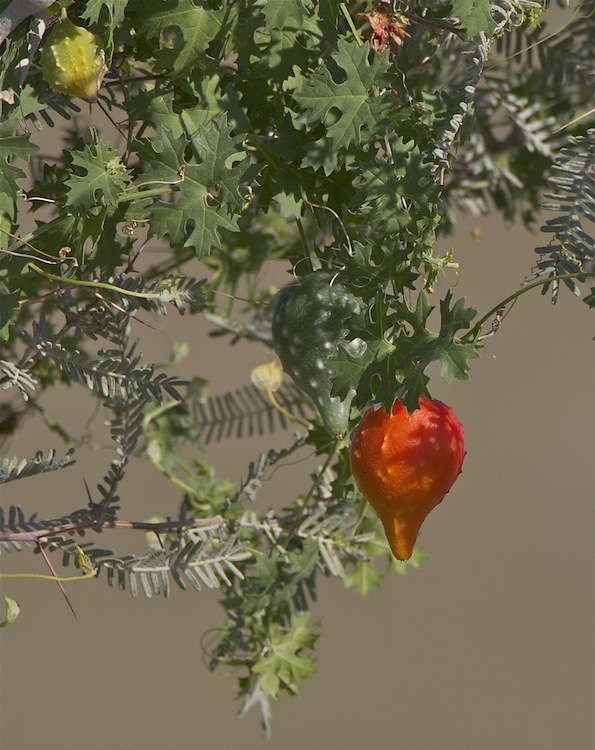 © ExFmem
© ExFmem
Kgalagadi Transfrontier Park
Description
Glabrous to slightly hairy perennial climbing herb with a tuberous rootstock, whole plant bad-smelling, more so when bruised. Stems mostly annual, prostrate or climbing, to 5 m long, cut twigs exude clear sap. Tendrils simple. Leaves waxy, lower surface paler than upper, deeply palmately 5-7-lobed, to 12 cm long, margin toothed, stalked.
Flowers solitary, male and female flowers on the same plant (monoecious). Male flowers prominently bracteate (subtended by a leaflet), bract ± ovate, to 18 mm long, pallid, green-veined, calyx green to purplish-black, corolla white to yellow, apricot or orange, green-veined, with grey, brownish or black spots near the bases of the three inner petals, 10-20 mm long, anthers orange. Female flowers inconspicuously bracteate, corolla rather smaller than males.
Fruit spindle shaped, dark green with 9 or 10 regular or irregular rows of cream or yellowish short blunt spines, ripening to bright orange or red, 25-60 mm long, opening automatically more or less irregularly into three valves that curl back (also opens when the tip is touched). Seeds ovate in outline, rather compressed, up to 11 mm long, light brown, surface sculptured; encased in a sticky scarlet red fleshy covering that is edible and sweet, tasting like watermelon.
Distribution
Common in tropical Africa, particularly in coastal areas, widespread in Namibia, Botswana, Swaziland and all the provinces of South Africa except the Western Cape. Also in Arabia, India and Australia.
Habitat
Grassland, savanna, woodland, forest margins, coastal dune forests and in river bank vegetation as well as disturbed areas.
Links: Biodiversity Explorer
Order: Cucurbitales. Family: Cucurbitaceae
 © ExFmem
© ExFmemKgalagadi Transfrontier Park
Description
Glabrous to slightly hairy perennial climbing herb with a tuberous rootstock, whole plant bad-smelling, more so when bruised. Stems mostly annual, prostrate or climbing, to 5 m long, cut twigs exude clear sap. Tendrils simple. Leaves waxy, lower surface paler than upper, deeply palmately 5-7-lobed, to 12 cm long, margin toothed, stalked.
Flowers solitary, male and female flowers on the same plant (monoecious). Male flowers prominently bracteate (subtended by a leaflet), bract ± ovate, to 18 mm long, pallid, green-veined, calyx green to purplish-black, corolla white to yellow, apricot or orange, green-veined, with grey, brownish or black spots near the bases of the three inner petals, 10-20 mm long, anthers orange. Female flowers inconspicuously bracteate, corolla rather smaller than males.
Fruit spindle shaped, dark green with 9 or 10 regular or irregular rows of cream or yellowish short blunt spines, ripening to bright orange or red, 25-60 mm long, opening automatically more or less irregularly into three valves that curl back (also opens when the tip is touched). Seeds ovate in outline, rather compressed, up to 11 mm long, light brown, surface sculptured; encased in a sticky scarlet red fleshy covering that is edible and sweet, tasting like watermelon.
Distribution
Common in tropical Africa, particularly in coastal areas, widespread in Namibia, Botswana, Swaziland and all the provinces of South Africa except the Western Cape. Also in Arabia, India and Australia.
Habitat
Grassland, savanna, woodland, forest margins, coastal dune forests and in river bank vegetation as well as disturbed areas.
Links: Biodiversity Explorer


